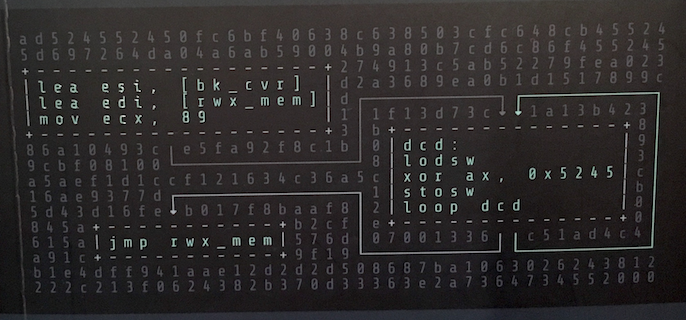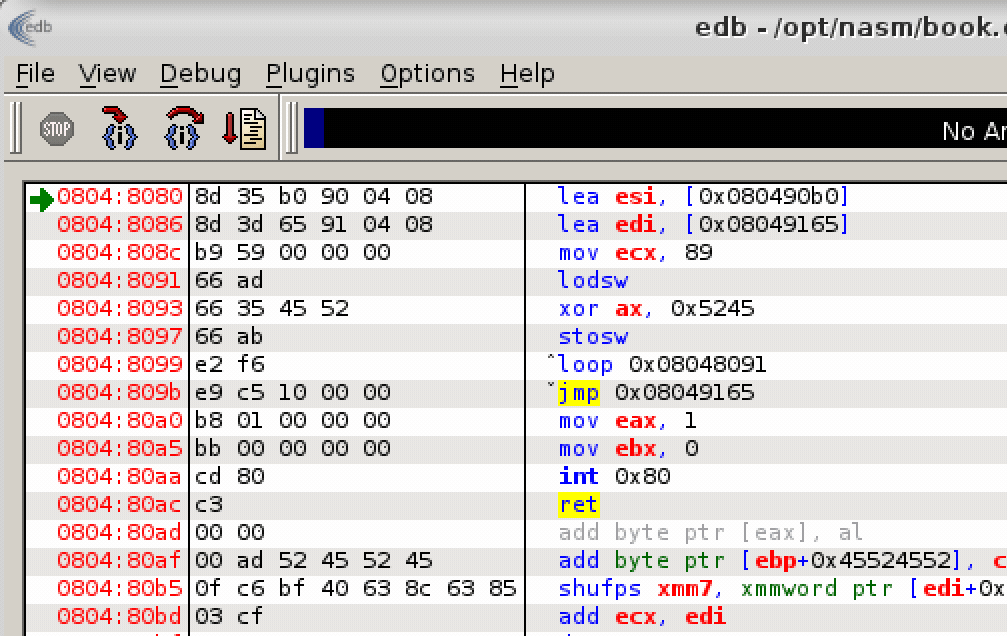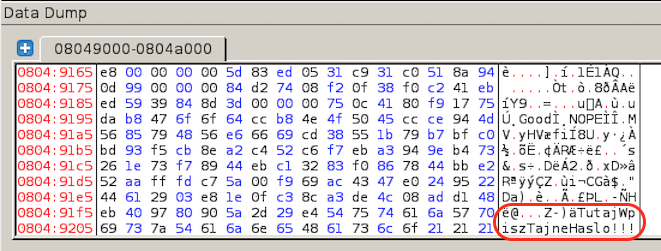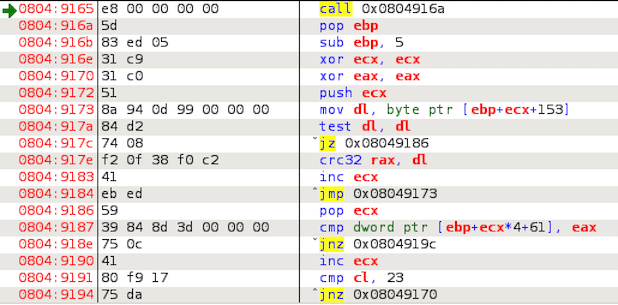Reverse Engineering a book cover - writeup
February 3, 2017
This writeup is really related to hacking and to be more precise cracking a real book cover. I bought this book some time ago as a pre-order.
UPDATE 02/03/2017
Gynvael mentioned my solution on his livestream (starts around 10m:40s): https://youtu.be/wJxWBeHWnGQ?t=640
The full title of this polish book is "Praktyczna inżynieria wsteczna" which we can translate to "Applied Reverse Engineering". The editorial board was Gynvael Coldwind and Mateusz Jurczyk. A lot of great people actually helped to create this book by writing articles, check it out.
Full details about that book: PWN bookstore
Book cover (take into account that the original book cover you can find on the Internet is different [without an assembly code] than this final one):

Recovering a code
Tools/Helps:
- x86 instructions - List of Assembly instructions on x86
- Kali Linux 32bit - Linux distributions with variety of tools
- EDB - x86 debugger (Pre-installed on Kali Linux)
- NASM - Assembly compiler (Pre-installed on Kali Linux)
Before we start analysing anything we need to copy the hex bytes and assembly code from a book cover. I recreated those bytes manually in a text editor without using any kind of OCR tool, it was the fastest method since we need to do that only once. No need for automation here.
HEX bytes:
ad524552450fc6bf40638c638503cfc648cb455245d697264da04a6ab59004b9a80b7cd6c86f455245274913c5ab52279fea023d2a3689ea0b1d1517899cd11f13d73c1a13b4233b886a10493ce5fa92f8c1b099cbf0810083a5aef1d1ccf121634c36a5cc16ae9377d1b5d43d16feb017f8baaf820845ab2cfe0615a576d07001336c51ad4c4a91c9f19b1e4dff941aae12d2d2d508687ba1063026243812222c213f0624382b370d33363e2a7364734552000
How do I know that bytes from a book cover are actually hexadecimal pairs? There are a few indicators that confirm my theory:
- Only valid HEX characters within a range A-F and 0-9.
- If you split the whole string into pairs of 2-bytes each you will get HEX encoded values like
0xAD,0x52… - A length of this string is actually 359 bytes and it doesn’t divide by 2 (359 % 2 !== 0) which means 358th is the last valid pair of 2-bytes and the next value is a single character. Nevertheless it doesn’t matter here, look at 3 last bytes which are
000, last valid HEX is0x00and one additional character is just a padding value to make a book cover look right.
Assembly code:
The full code that is ready to compile is here: Pseudo code from a book cover ported to NASM · GitHub
lea esi, [bk_cvr]
lea edi, [rwx_mem]
mov ecx, 89
dcd:
lodsw
xor ax, 0x5245
stosw
loop dcd
jmp rwx_mem
At first when I looked at this snippet I thought it’s just a random assembly code but then I tried to expand those acronyms like [bk_cvr] and [rwx_mem].
- bk_cvr - it expands to book cover
- rwx_mem - here is a memory with access rights to read, write, execute (rwx).
This assembly fragment executes from the top to the bottom:
- Assign to ESI register an address to HEX bytes from a book cover.
- Assign to EDI register an address of the allocated memory space where we can put our decoded bytes.
- Set the value of ECX register to 89 (decimal).
- Set a label called “dcd” so we can reference to it from a loop or JMP directives (like with a label for goto directive).
- lodsw - Load word at address defined by ESI (hex character from a book cover) into AX register. After a first iteration EAX = 0x000052ad.
- XOR value in AX register with 0x5245 (AX = 0x52ad XOR 0x5245 = 0x00e8).
- stosw - store the XOR result (AX = 0xe8) at the memory address from EDI register (rwx_mem).
- Jump to “dcd” label and repeat the whole process 89 times (ECX), decreasing ECX every next loop iteration.
- After the whole process finished we can jump to the address where “rwx_mem” is pointing to. It’s going to be an actual code that parses.
Decoding HEX bytes

After all bytes were decoded and copied we can find an actual string that says we need to put a password there. Mentioned string is marked by a red square on a picture bellow:

You should notice the sentence which wasn’t visible before, TutajWpiszTajneHaslo!!!. It’s a Polish sentence which translates into English as PutYourSecretPasswordHere!!!. I’m going to refer to this as a hidden message.
Bellow is the code where we jumped to from the instruction jmp rwx_mem:

Mentioned code is pretty straightforward and what it does is a simple iteration over our hidden message to generate the CRC32 checksum. We need to be aware of that the assembly instruction CRC32C is actually not a standard CRC32 function which is commonly used. There is a special instruction set called SSE4 which introduced this function in the Intel processors - SSE4 - Wikipedia. It’s CRC32C which does return a different result than a standard function.
Within this loop which repeats exactly 23 times (the string length of TutajWpiszTajneHaslo!!!) we calculate CRC32C checksum:
- 1st iteration: CRC32C is calculated using
TutajWpiszTajneHaslo!!!. - 2nd iteration: CRC32C is calculated using
utajWpiszTajneHaslo!!!. - 3rd iteration: CRC32C is calculated using
tajWpiszTajneHaslo!!!.
Every next iteration CRC32C checksum calculation starts at the n-th letter. At the end this code will calculate a checksum only from the laster letter - that’s an important information.
Instruction cmp dword ptr [ebp+ecx*4+61], eax is checking if generated CRC32C value is the same as one stored at the address ebp+ecx*4+61 (it’s an array of checksums). If it does match then we start another loop iteration, if not then code “stops”.
The obvious thing is that I didn’t have any checksum that was matching those checksums referenced within an array, even after the first loop iteration my generated CRC32C was invalid. At first I thought maybe this XOR decoding routine broke something and that’s the reason checksum doesn’t match…
There is an array that stores 23 different CRC32C checksums that are compared to those generated from TutajWpiszTajneHaslo!!!. After some checks I realised that code is actually valid and XOR decoding procedure also works fine.
Magic checksums
If you modify mentioned hidden message your CRC32C checksum will change. Here comes a tricky part, if we have an array with 23 valid checksums we need to generate a new hidden message that will match exactly those values.
Not only the checksum of the whole hidden message needs to be valid but also every its character. It means that finding the collision in CRC32C will not resolve our issue, we need to brute force that. We know exactly what is a value of CRC32C checksum in every step of our loop.
Pseudocode for mentioned brute-force script:
We iterate from the last character to the first one, in a reverse order.
- Dump a list of all valid checksums (array) from the memory.
- Iterate from the last CRC32C value in that array.
- Generate checksum for every character in a range 0-255.
- If generated checksum does match then move to the next valid checksum and repeat that process.
- At the end we’re going to receive a valid string that matches to all checksums.
I dumped the memory after XOR operation directly from EDB to a file named decoded.dump.bin.
PHP snippet that extracts valid checksums from a memory dump:
<?php
$file = file_get_contents('decoded.dump.bin');
$offset = 0x19E;
$crc32Table = array();
$fakePassword = 'TutajWpiszTajneHaslo!!!';
$numOfCrcItems = strlen($fakePassword);
$wSz = 4;
function get4byteVal($str) {
$res = '';
for ($i = 3; $i >= 0; $i--) {
$res .= sprintf('%02x', ord($str[$i]));
}
return sprintf('0x%s', $res);
}
for ($i = 0; $i < $numOfCrcItems; $i++) {
$seek = $offset + ($wSz * $i);
$crc32Table[] = get4byteVal(substr($file, $seek, $wSz));
}
print_r($crc32Table);
As a result the list of checksums is:
Array
(
[0] => 0x564d94ce
[1] => 0x56487985
[2] => 0xcd6966e6
[3] => 0x791b5538
[4] => 0xbdc0bfb7
[5] => 0x8ecbf593
[6] => 0xc652c4a2
[7] => 0x94a3ebf7
[8] => 0x2673b49e
[9] => 0x89f7731e
[10] => 0x32c1eb44
[11] => 0x7886f083
[12] => 0x52e2bb44
[13] => 0xc7fdffaa
[14] => 0x69f9005a
[15] => 0xe04743ac
[16] => 0x44229524
[17] => 0xe8032961
[18] => 0x8cc30f1e
[19] => 0x084cdea3
[20] => 0xeb48d1ad
[21] => 0x90809740
[22] => 0xe4292d5a
)
Brute-force
We have everything we need to know, how to find valid checksums and write brute-force code. I struggled here for a while because every software implementation of CRC32C I did find wasn’t generating a valid result. I tried C, Python and Node.JS libraries, without a success. That was the main reason why I decided to write this brute-force script in a pure assembly. I can use there built-in hardware support for CRC32C instruction without a need to actually use any external libraries.
I was using NASM for that, here is a code:
; compile: nasm -f elf poc.decode.flag.asm; ld -m elf_i386 -s -o poc.decode.flag poc.decode.flag.o
; author: @radekk
; -------------------------------------------
bits 32
section .data
string times 25 db 0
sizeOfString equ $-string
crc32table dd 0x564d94ce, 0x56487985, 0xcd6966e6, 0x791b5538, 0xbdc0bfb7, 0x8ecbf593, 0xc652c4a2, 0x94a3ebf7, 0x2673b49e, 0x89f7731e, 0x32c1eb44, 0x7886f083, 0x52e2bb44, 0xc7fdffaa, 0x69f9005a, 0xe04743ac, 0x44229524, 0xe8032961, 0x8cc30f1e, 0x084cdea3, 0xeb48d1ad, 0x90809740, 0xe4292d5a
section .text
global _start
_start:
xor esi, esi
mov ebx, 22 ; number of crc32 hashes (index)
call _brute
call _print
call _close
ret
_brute:
mov ecx, 255 ; max ascii code for character
_loopA:
xor edx, edx
xor eax, eax
crc32 eax, cl
cmp esi, 1
je _crc32
jmp _cmp
_crc32:
inc edx
crc32 eax, byte [string + ebx + edx]
cmp byte [string + ebx + edx + 1], 0
jne _crc32
_cmp:
cmp eax, [crc32table + ebx * 4]
je _found
loop _loopA
ret
_found:
mov esi, 1
mov byte [string + ebx], cl
dec ebx
jmp _brute
_print:
mov edx, sizeOfString
mov ecx, string
mov ebx, 1
mov eax, 4
int 0x80
jmp _close
_close:
mov eax, 1 ;system call number (sys_exit)
mov ebx, 0
int 0x80 ;call kernel
ret
As a result it prints out a new valid hidden message:
root@kali:/opt/nasm $> ./poc.decode.flag; echo ""
coldwind.pl/piwflag1337
Our flag is: coldwind.pl/piwflag1337
This is an actual URL address http://coldwind.pl/piwflag1337 where details for winners were described.